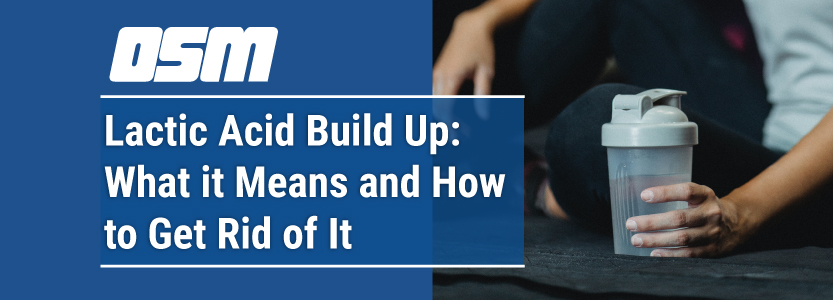Lactic Acid Build Up: What It Means and How to Get Rid of It
Article featured on Verywell fit
Lactic acid is created when the body turns glucose into energy. The production of lactic acid occurs when oxygen levels are low, generally during high-intensity exercise. Lactic acid build-up can hinder your exercise routine, so it’s important to understand why it happens and how to prevent it.
What Lactic Acid Is
Lactic acid is produced in muscle cells and red blood cells. It forms when the body breaks down carbohydrates for glucose during exercise in certain conditions. “Lactic acid is a result of glycolysis (or the breakdown of glucose), an energy system that creates ATP energy in the absence of oxygen in muscle cells,” says Jenna Braddock, MSH, RD, CSSD, ACSM-CPT, owner of MakeHealthyEasy.com and OffSeasonAthlete.com.
Braddock also notes that there is a difference between lactic acid and lactate. Although the two words are used interchangeably, they are not technically the same.
Lactic acid has a hydrogen ion that is available to donate, while lactate is the molecule left after that hydrogen ion is cleaved from the molecule.
“This distinction helps us understand what is happening in the body; lactate is a fuel source for the body and has many important functions,” adds Braddock. During exercise, the working muscle cells can continue anaerobic energy production for one to three minutes, during which you can perform at high levels.
Why Lactic Acid Builds Up
During high-intensity exercise, muscles require more oxygen than the body can take in, causing anaerobic respiration and lactic acid build-up. When lactic acid develops depends on a person’s fitness level. The body clears lactic acid when it develops, but it may not be able to keep up when the levels start to increase rapidly.
“This is often termed “lactate threshold” for high-intensity aerobic activities (like running), but keep in mind lactate accumulation can also occur with strength training,” says Chrissy Carroll, RRCA Running Coach at Snacking in Sneakers.
When this increased acid builds, the muscles get tired and may not be able to contract as effectively. Some people may notice a burning sensation in the muscle during exercise.
“Interestingly, some experts believe the production of lactate actually helps the muscles delay fatigue during intense exercise,” says Carroll. She also notes that contrary to popular belief, the lactic acid buildup is not what’s responsible for delayed onset muscle soreness that occurs in the 24-48 hours after a workout.
How to Get Rid of It
“Decreasing the exercise intensity, resting from the activity, and taking deep breaths may all be helpful ways to clear lactic acid during an exercise session,” says Carroll.
Another proven method for clearing lactic acid is engaging in active recovery after exercise. Low-intensity movements, like yoga, walking, biking, or foam rolling, may clear lactic acid from the body.
A study compared active and passive recovery in 14 downhill skiers and found that active recovery caused a greater decrease in lactic acid. Skiers who performed the active recovery were able to move faster and complete more runs.
Ways to Get Rid of Lactic Acid
- Decreased exercise intensity
- Resting
- Taking deep breaths during exercise
- Active recovery or low-intensity movements, such as yoga, walking, biking, or foam rolling
How to Prevent Lactic Acid Build-Up
“The feeling of burning and fatigue that is associated with lactic acid can be improved most significantly through training,” says Braddock. She recommends increasing volume, intensity, and duration of training gradually to prevent lactic acid buildup.
But, “you do not have to avoid lactic acid build-up completely,” according to Carroll. “It’s normal for certain training regimens to include high-intensity intervals that are completed above the lactate threshold, couched between easier training days and/or rest days, to allow for proper training adaptations and recovery,” Carroll adds.
Braddock also notes that fueling properly for a workout can positively affect lactic acid levels. “Beta-alanine3 is a supplement that can be used to delay the impacts of lactate accumulation, but it may negatively impact other areas of performance,” says Braddock.
She also urges athletes to work with an experienced sports dietitian to develop a fueling and supplement plan that’s right for them.
How to Prevent Lactic Acid Build-Up
- Increase volume, intensity, and duration of training gradually
- Incorporate rest days and easier training days
- Fuel your body properly
- Consider working with a sports dietitian to develop a custom fueling and supplement plan
The Orthopedic & Sports Medicine Center of Oregon is an award-winning, board-certified orthopedic group located in downtown Portland Oregon. We utilize both surgical and nonsurgical means to treat musculoskeletal trauma, spine diseases, sports injuries, degenerative diseases, infections, tumors and congenital disorders.
Our mission is to return our patients back to pain-free mobility and full strength as quickly and painlessly as possible using both surgical and non-surgical orthopedic procedures.
Our expert physicians provide leading-edge, comprehensive care in the diagnosis and treatment of orthopedic conditions, including total joint replacement and sports medicine. We apply the latest state-of-the-art techniques in order to return our patients to their active lifestyle.
If you’re looking for compassionate, expert orthopedic surgeons in Portland Oregon, contact OSM today.
Phone:
503-224-8399
Address
17355 Lower Boones Ferry Rd Suite 100A
Lake Oswego, OR 97035
Hours
Monday–Friday



